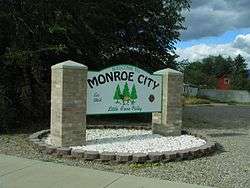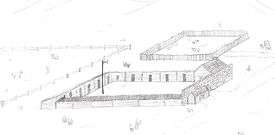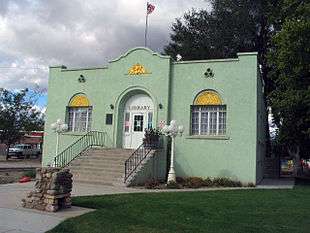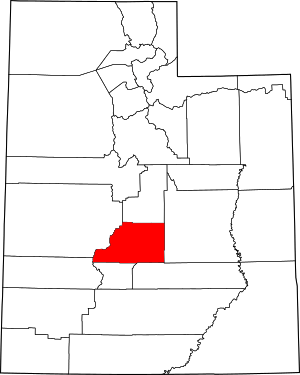Monroe, Utah
Monroe is a city in Sevier County, Utah, United States. The population was 2,256 at the 2010 United States Census. The city is home to both Mystic Hot Springs and South Sevier High School.
Monroe | |
|---|---|
 Welcome sign at the northern entrance to Monroe | |
 Seal | |
| Nickname(s): The Little Green Valley | |
 Location in Sevier County and the state of Utah. | |
| Coordinates: 38°37′46″N 112°7′13″W | |
| Country | United States |
| State | Utah |
| County | Sevier |
| Settled | 1864 |
| Incorporated | 1920 |
| Named for | James Monroe |
| Area | |
| • Total | 3.57 sq mi (9.25 km2) |
| • Land | 3.57 sq mi (9.25 km2) |
| • Water | 0.00 sq mi (0.00 km2) |
| Elevation | 5,394 ft (1,644 m) |
| Population (2010) | |
| • Total | 2,256 |
| • Estimate (2019)[2] | 2,358 |
| • Density | 660.32/sq mi (254.97/km2) |
| Time zone | UTC-7 (Mountain (MST)) |
| • Summer (DST) | UTC-6 (MDT) |
| ZIP code | 84754 |
| Area code(s) | 435 |
| FIPS code | 49-51360[3] |
| GNIS feature ID | 1443556[4] |
| Website | www |
Geography
Monroe is located in rural central Utah. According to the United States Census Bureau, the city has a total area of 3.5 square miles (9.2 km2), all of it land. Monroe is bordered by mountains on the east and south, and farmers' fields to the west and north.
Monroe is home to naturally occurring hot springs with travertine deposits, a result of the Monroe-Red Hill geothermal system found along the Sevier fault.[5] On the east side of town, hot water surfaces at a temperature of 168 °F and a rate of about 200 gallons per minute. A travertine mound has formed, known as the Monroe Mound. This deposit stretches one mile across, 200 yards wide, and a few hundred feet thick. There is another hot water source about a mile north of town called the Red Hill Hot Springs. It also surfaces at 168 °F, but at a rate of about 100 gallons per minute. The Red Hill mound is about one-third of a mile across, and deep red in color.
Demographics
| Historical population | |||
|---|---|---|---|
| Census | Pop. | %± | |
| 1880 | 744 | — | |
| 1890 | 880 | 18.3% | |
| 1900 | 1,057 | 20.1% | |
| 1910 | 1,227 | 16.1% | |
| 1920 | 1,719 | 40.1% | |
| 1930 | 1,247 | −27.5% | |
| 1940 | 1,292 | 3.6% | |
| 1950 | 1,214 | −6.0% | |
| 1960 | 955 | −21.3% | |
| 1970 | 918 | −3.9% | |
| 1980 | 1,476 | 60.8% | |
| 1990 | 1,472 | −0.3% | |
| 2000 | 1,845 | 25.3% | |
| 2010 | 2,256 | 22.3% | |
| Est. 2019 | 2,358 | [2] | 4.5% |
| U.S. Decennial Census[6] | |||
As of the census[3] of 2000, there were 1,845 people, 707 households, and 480 families residing in the Monroe. The population density was 521.7 people per square mile (201.2/km2). There were 707 housing units at an average density of 199.9 per square mile (77.1/km2). The racial makeup of the city was 95.83% White, 0.22% African American, 1.41% Native American, 0.27% Asian, 0.11% Pacific Islander, 0.65% from other races, and 1.52% from two or more races. Hispanic or Latino of any race were 5.69% of the population.
There were 636 households, out of which 37.3% had children under the age of 18 living with them, 69.5% were married couples living together, 8.2% had a female householder with no husband present, and 19.5% were non-families. 18.4% of all households were made up of individuals, and 11.6% had someone living alone who was 65 years of age or older. The average household size was 2.90 and the average family size was 3.31.
In the city, the population was spread out, with 32.2% under the age of 18, 8.1% from 18 to 24, 21.2% from 25 to 44, 23.0% from 45 to 64, and 15.4% who were 65 years of age or older. The median age was 36 years. For every 100 females, there were 90.0 males. For every 100 females age 18 and over, there were 89.0 males.
The median income for a household in the city was $34,907, and the median income for a family was $37,415. Males had a median income of $31,797 versus $17,981 for females. The per capita income for the city was $14,331. About 5.0% of families and 7.7% of the population were below the poverty line, including 7.4% of those under age 18 and 8.1% of those age 65 or over.
History
In late 1863, a few exploratory settlers came to Monroe. This small group included George Wilson, his son David, and two others who were seeking to settle in this valley. They made a dugout and spent the winter at what is now considered near the center of the town. They were followed by the first permanent group of settlers, who arrived in Monroe on 20 February 1864.[7] Most, if not all, of the first Settlers were members of The Church of Jesus Christ of Latter-day Saints (LDS Church), who had immigrated to Utah. Around 4 to 5 months before the first small group of men entered Monroe valley to begin settlement, an advanced team, also lead by George Wilson, began to lay some foundation work to help prepare the settlement.[7]
At first the town was called South Bend (due to the proximity to a bend in the Sevier River), but soon after its settlement it was renamed Alma, in honor of the Book of Mormon prophet. It is estimated that by the end of 1864 around 20 families were living in Alma. They spent the first year building small homes and dugouts, along with clearing space for fields and pastures.[8]
Initially settling in the Salt Lake Valley did not provoke the Native Americans to war, but further settlement outside of Salt Lake provoked the Native Americans to more aggressive behavior. As settlement in these valleys increased, the Native Americans were pushed back into the mountains.[7] In April 1865 the Black Hawk War broke out between local Native Americans and the Settlers of both the Sevier and Sanpete Counties. The war drastically ended the progress which was being made in creating farms and homes in and around Alma.[8] On the night of the 21st of April, 1866, Walter Barney and Sidney Robinson were on guard watching the public corral when they spotted something lying on the fence when making their nightly rounds. When approached, they realized that it was two Native Americans. After chasing them away, they went back to the fence and realized that they had been digging around the poles to break the boundary around the corral.[7]
Alma had been settled in the middle of the Native American's hunting grounds and as a result they started to go hungry. During the war Native Americans were constantly trying to steal the Settler's stock for food, and they were successful during several raids.

Sometime during 1865 work began on a fort to provide protection for both the Setters and their stock. The fort was completed and contained several homes, a blacksmith shop, along with a corral and stockyard for the animals. This fort, named Fort Alma, provided protection for about two years, but things continued to get more dangerous and in April 1867 the Settlers of Alma were evacuated. Most of the evacuees made temporary homes in Sanpete County, until they could return home.
An attempt to resettle Alma was made during 1868, but the Settlers ran into Native Americans near Cedar Ridge (now Vermillion, Utah) and a battle ensued. They were unsuccessful in resettling Alma, and it was not until March 1871 that Settlers were finally able to return to Alma. The following year they applied for a Post Office under the city name of Monroe, in honor of U.S. President James Monroe. By the end of 1872 the telegraph had been extended through Monroe, which connected it with the rest of Utah. In 1889 Monroe was incorporated as a town and remained that way until 1921 when it was incorporated as a city.[8]
History of Monroe Hot Springs
In 1882, Thomas Cooper and his wife homesteaded the area on the east side of town where hot springs water emerged. They built a wood box to collect the water and offered it as a soaking pool. Later, around 1905, a building was erected. There was a dance floor, an indoor swimming pool, and many dressing rooms. Many people came from miles around by horse and buggy to enjoy soaking and dancing. In 1930 Farnsworth bought the hot springs. He was the leader of a band, and it became the house band. The slogan for the Monroe hot springs was, "the home of mirth and merriment".[9] The hot springs enjoyed many years of prosperity until around 1950. It was revitalized in the 1970s. The name was changed to Mystic Hot Springs in 1995. Mike Ginsburg has been operating the facility since 1996. There are two hot springs soaking pools and 6 big bath tubs filled with the hot springs water. They host music concerts regularly and have a Music Festival around the July 24th holiday.
Monroe Today

Monroe currently has a Grocery store (GG's), Alvey Lumber, Bullies Drive-In, a physical therapist (South Central Therapies), a dentist (Chisholm Dentistry), Monroe Canyon Assisted Living Center/Clinic, South Sevier Medical Clinic (IHC), some hair salons, VBar Gun Repair, Revere Health Family Medicine, Shaka Shack Shave Ice, an Art Gallery, and a couple accounting offices. Monroe also has many new subdivisions and is nicknamed "The Little Green Valley" due to the many fields that surround the city.
PIONEER DAY CELEBRATION
Monroe hosts the largest Pioneer Day Celebration in Sevier County. Made famous by its parade and 3-on-3 Basketball tournament, the 24th in Monroe is full of food trucks, vendors, bike rides, the Monroe Milk Run, live bands in the historic Main Street theater, class reunions, an epic firework show on the SSMS football field, and a community BBQ hosted by the city on the park.
Education
The schools for most of the surrounding areas are also located in Monroe, which has Monroe Elementary (K-5), South Sevier Middle School (6-8), and South Sevier High School (9-12). School age children are traditionally bused from the neighboring towns of Central Valley, Annabella, Elsinore, Joseph, and Sevier to Monroe to attend school. Navajo placement students are also traditionally bused to the schools from a dormitory in Richfield.
Notable Person
- State Senator Ralph Okerlund, Majority Leader of the Utah State Senate, and former chairman of the Utah Senate Redistricting Committee.
- Pharmacist (Bob Leaver)
See also
- Fremont Indian State Park
- www.mystichotsprings.com
References
- "2019 U.S. Gazetteer Files". United States Census Bureau. Retrieved August 7, 2020.
- "Population and Housing Unit Estimates". United States Census Bureau. May 24, 2020. Retrieved May 27, 2020.
- "U.S. Census website". United States Census Bureau. Retrieved 2008-01-31.
- "US Board on Geographic Names". United States Geological Survey. 2007-10-25. Retrieved 2008-01-31.
- http://pangea.stanford.edu/ERE/pdf/IGAstandard/SGW/1979/Harrison.pdf DEVELOPMENT AND TESTING OF A SMALL MODERATE TEMPERATURE GEOTHERMAL SYSTEM
- "Census of Population and Housing". Census.gov. Retrieved June 4, 2015.
- Murdock, Wilford (1964). Monroe, Utah: Its First One Hundred Years. Monroe: Monroe Centennial Committee and Monroe City.
- "Early History of Monroe, Utah". Monroe, Utah History Online. Archived from the original on December 23, 2010. Retrieved August 29, 2009.
- Murdock, Wilford (1964). Monroe, Utah: Its First One Hundred Years. Monroe: Monroe Centennial Committee and Monroe City. pp. 62–63.
External links
| Wikimedia Commons has media related to Monroe, Utah. |
